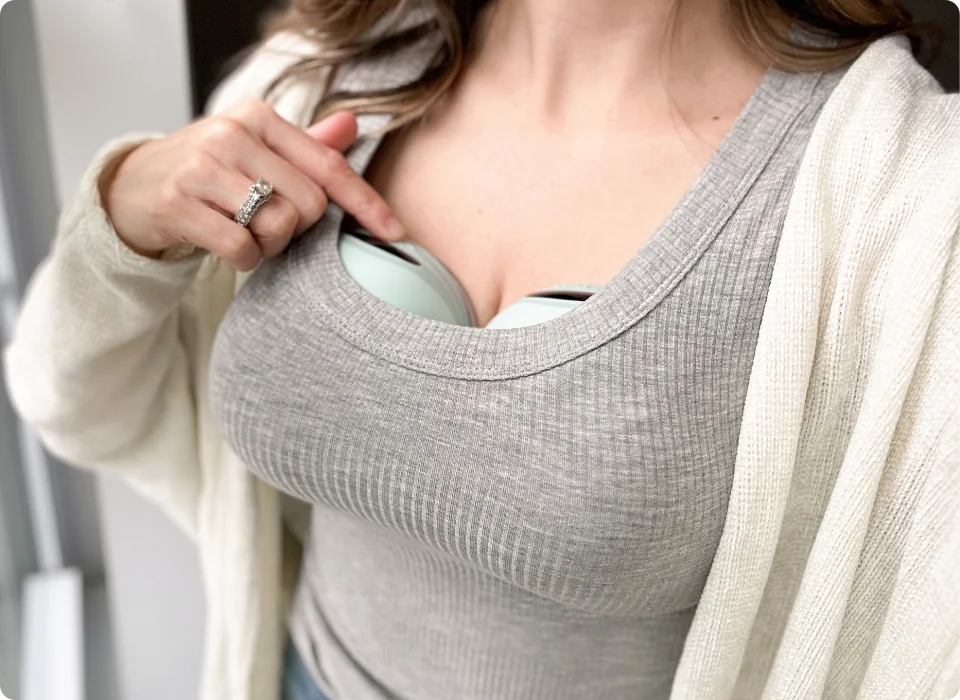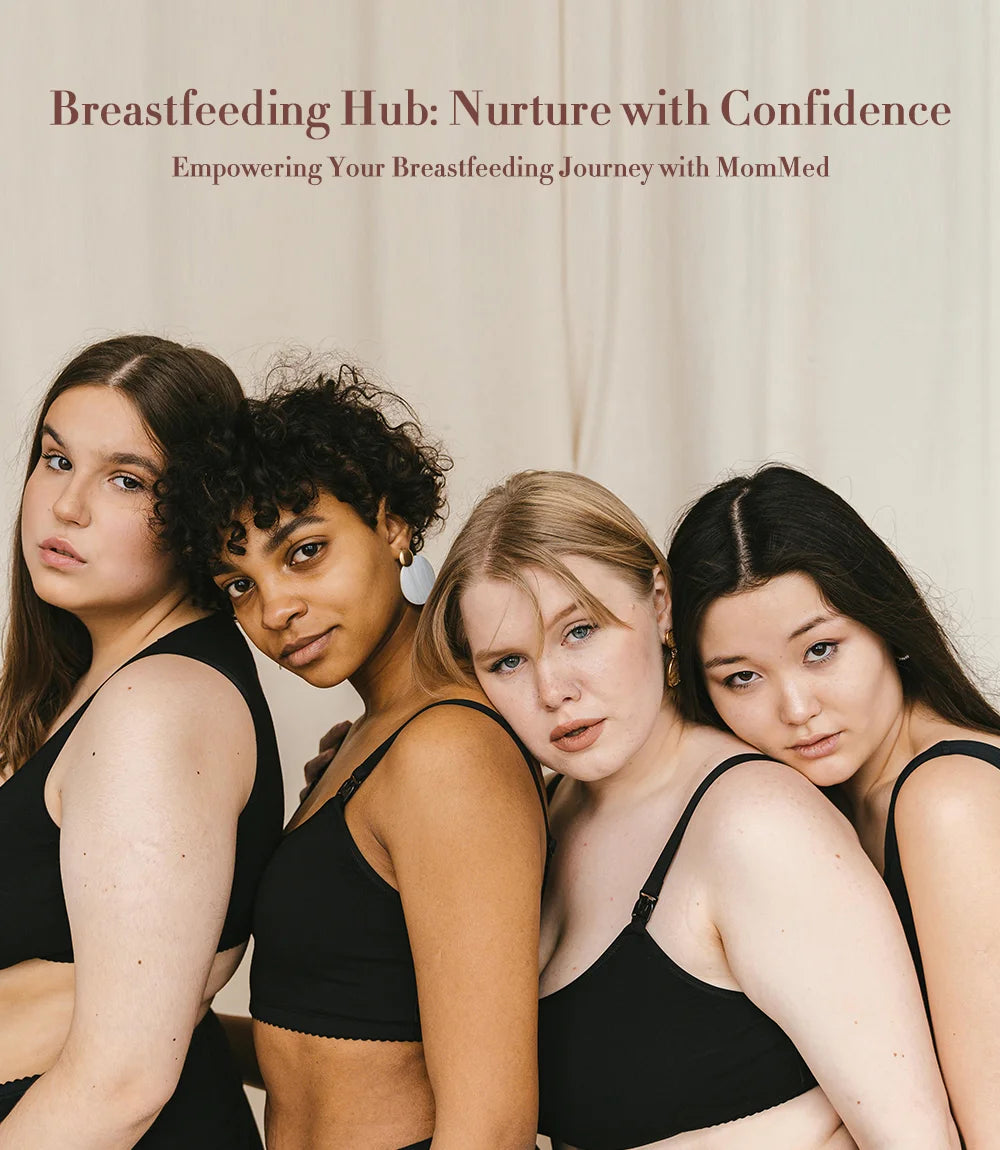Welcome to MomMed’s Breastfeeding Hub
MomMed is committed to supporting and empowering mothers with valuable information and resources. Explore our comprehensive guides and tips below to enhance your breastfeeding journey.

The Importance of Breastfeeding
Discover the health benefits breastfeeding offers to both your baby and you.
For Baby
Research suggests that breastfeeding lowers your baby’s risk of certain diseases and helps build a strong immune system. Breastfed babies have a lower risk of diarrhea, vomiting, preterm necrotizing enterocolitis (NEC), respiratory infections like pneumonia and RSV, ear infections, bacterial meningitis, asthma, SIDS, childhood obesity, eczema, Type 2 diabetes later in life, leukemia (in childhood), cavities, future orthodontic problems, celiac disease, and inflammatory bowel disease (IBD).
Breast milk contains everything your baby needs to grow and develop. It provides a unique and specific formula of vitamins, minerals, and antioxidants that support your baby’s health. Breast milk is easy for their immature tummy and intestines to digest, contains antibodies that protect against infection, has the right amount of fat, sugar, water, protein, and vitamins, promotes healthy weight gain, changes in composition to meet your baby’s nutritional needs over time, and contains substances that naturally soothe your baby.
For Mom or Breastfeeding Parent
Breastfeeding lowers your risk of postpartum depression if breastfeeding is going well and you feel supported. It also reduces the risk of developing breast cancer, ovarian cancer, endometrial cancer, thyroid cancer, osteoporosis, Type 2 diabetes, cardiovascular disease, high blood pressure, and high cholesterol.
Breastfeeding increases physical and emotional bonding with your baby through the release of oxytocin, which helps establish trust and strengthens the emotional connection. This bonding may help reduce social and behavioral problems in both children and adults.

Choosing the Right Breast Pump
Learn how to select the perfect breast pump that suits your needs to ensure a smooth breastfeeding experience.
FAQs
- Manual vs. Electric: Manual pumps are great for occasional use due to their portability and affordability. Electric pumps are more efficient and suitable for frequent use, especially for working mothers.
- Single vs. Double: Single pumps are ideal for occasional pumping, while double pumps are efficient for regular use, saving time by pumping both breasts simultaneously.
Read: Electric Breast Pump Vs Manual: What’s the Difference?
Read: Double Pumping Vs Single Pumping: What’s the Difference?
When selecting a breast pump, consider whether a manual or electric pump suits your needs. Manual pumps are portable and affordable, ideal for occasional use. Electric pumps are efficient and suitable for regular use, especially if you're returning to work. Look for features like adjustable suction levels and portability.
- S21 Breast Pump: The S21 breast pump offers unmatched convenience for on-the-go nursing mothers with its compact design and advanced features. It has an LED screen and physical buttons for durability, operates quietly at less than 45 dB, and provides 3 modes and 12 intensity levels. With a long battery life for 4-6 sessions, a 6oz capacity, and a 105° ergonomic flange, the lightweight and comfortable S21 ensures discreet and efficient pumping anytime, anywhere.
- S10 Pro Breast Pump: The S10 Pro breast pump is perfect for mothers with high pumping needs, offering efficient milk expression and personalized settings. It features a large capacity, extended battery life for 6-8 sessions per charge, and 3 modes with 9 intensity levels. The 105° ergonomic flange ensures a comfortable fit for most breasts, while the wider display with an embedded timer adds convenience for all-day use.
MomMed offers product warranties and dedicated customer support. Refer to our Warranty and Support section for more details.
SHOP MOMMED PUMPS

Breast Pump Usage Guide
Follow our step-by-step instructions on how to use, clean, and maintain your breast pump effectively for optimal performance.
Start by sterilizing all pump parts. Position the flange over your nipple, ensuring a good seal. Begin with a gentle suction and gradually increase it. Pump for 15-20 minutes on each breast. Clean and sterilize the parts after each use to maintain hygiene and prevent infections.
Choosing the right flange size is crucial for comfort and efficient milk extraction. Measure the diameter of your nipple (not the areola) and select a flange that is slightly larger to ensure a proper fit.
Regular replacement of breast pump parts is necessary to maintain performance and hygiene. Check our detailed guide on recommended replacement intervals based on usage frequency.
Proper cleaning involves disassembling all parts, washing with warm soapy water, rinsing thoroughly, and sterilizing. Follow our step-by-step cleaning guide for best practices.
Many insurance plans cover breast pumps. Contact your insurance provider to understand the coverage and required documentation. Our guide on obtaining a breast pump through insurance provides detailed steps.

Breastfeeding Tips
Find helpful advice and solutions for common breastfeeding challenges to make your nursing journey easier and more enjoyable.
Establishing an effective pumping routine involves pumping at regular intervals, ideally every 3-4 hours, to mimic your baby's feeding schedule. This helps maintain a consistent milk supply. Morning sessions are often more productive, so consider starting your day with a pumping session.
To establish a good latch, ensure your baby's mouth covers both your nipple and a large portion of the areola. This helps the baby effectively extract milk and prevents nipple soreness. Different positions, such as the cradle hold or football hold, can help find what works best for you and your baby.
Common issues like soreness and engorgement can be managed with proper techniques and support. Using nipple creams, ensuring a proper latch, and feeding or pumping regularly can alleviate these problems. If you continue to experience difficulties, consulting a lactation expert can provide personalized solutions.
Frequent breastfeeding or pumping helps stimulate milk production. Avoid bottles and pacifiers early on to encourage direct breastfeeding. Stay hydrated and eat a well-balanced diet rich in nutrients. Rest and stress reduction are crucial, as stress can affect milk supply. Experiment with different breastfeeding positions and techniques, and consider using an electric breast pump to maintain and increase supply.

Breastfeeding Health and Nutrition
Understand the importance of a balanced diet and self-care practices to support your health and your baby’s development while breastfeeding.
A balanced diet rich in fruits, vegetables, whole grains, and lean proteins is essential. Certain nutrients, like DHA found in fatty fish, support your baby's brain development. Staying hydrated is also crucial, so drink plenty of water throughout the day.
Self-care is vital for breastfeeding mothers. Ensure you get enough rest, practice stress-reducing techniques, and seek support when needed. Gentle postpartum exercises can help you regain strength and energy. Remember, taking care of yourself is essential to taking care of your baby.
Including essential nutrients in your diet is crucial for both you and your baby. Focus on consuming a variety of fruits, vegetables, whole grains, and lean proteins. Omega-3 fatty acids, found in foods like fish and flaxseeds, are particularly beneficial for your baby's brain development. Staying hydrated by drinking plenty of water is also essential, as it helps maintain milk production.
Starting with gentle postpartum exercises can help you regain strength and stamina. Walking, pelvic floor exercises, and light stretching are excellent for early postpartum recovery. Gradually incorporate more vigorous activities like swimming or postpartum yoga as you feel stronger. Always consult with your healthcare provider before starting any exercise routine.

Frequently Asked Questions
Get answers to common concerns about breastfeeding, from milk supply to storage, ensuring you feel confident and informed.
Signs your baby is getting enough milk include steady weight gain, regular wet diapers (6-8 per day), and a content demeanor after feedings. Monitoring these indicators can reassure you that your baby is well-nourished.
Freshly expressed breast milk can be stored in the refrigerator for up to 4 days and in the freezer for up to 6 months. Use sterilized containers or breast milk storage bags, label them with the date, and follow proper thawing techniques to maintain milk quality and safety.
Yes, breastfeeding can be both convenient and cost-effective. It naturally provides all the necessary nutrients for your baby without the need for purchasing formula, which can add up in cost over time.
Breastfeeding can help with postpartum weight loss as it burns calories. However, weight loss varies among individuals due to factors like calorie consumption, physical activity, and sleep quality.
Studies suggest that breastfeeding has a positive long-term effect on brain and behavioral development. However, there is no conclusive evidence that breastfed babies are smarter than formula-fed babies. Both breastfeeding and formula feeding support your baby’s growth and development.
If breastfeeding isn’t possible due to medical conditions, surgeries, or other constraints, talk to your baby’s pediatrician about the best formula for your baby. They can also guide you on the use of donated human milk if necessary. Consulting a lactation consultant or breastfeeding medicine specialist can help overcome challenges like low milk supply.

Support and Community
Connect with other moms for advice, support, and shared experiences.
Facebook Breasfeeding Support Group











